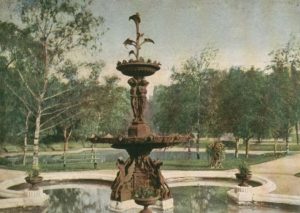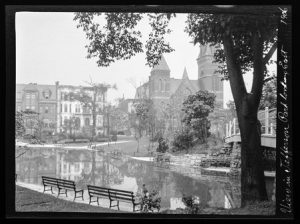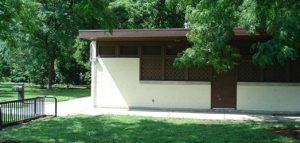HISTORY – SKINNER PARK

Fountain – Skinner Park (Jefferson Park – 1850)
Skinner Park, originally named Jefferson Park, was created and build in 1848 -1850. It is the second oldest park in Chicago and the first park in Chicago’s West Side parks system.
Nearby Union Park’s 13 acres was built in 1873 when residents convinced developers to sell the land at discount for the creation of a park. Further West, Garfield Park was created in 1874, from an original 40 acre parcel and over the years has grown to almost 185 acres.

Mirror Lake view Skinner Park (Jefferson Park), Chicago, IL 1906.
Though small, Skinner Park ( Jefferson Park ) was considered to be one of the most lovely and gracious parks during its heyday. In the one square block that composed of the park, one could find winding walking paths, a lake, grottoes, and a beautiful fountain where friends would gather to socialize. The park was featured in the novel Sister Carrie by Theodore Dreiser, considered to one of the great American novels.
OVER THE YEARS…
In 1955, Jefferson Park was renamed Skinner Park. Along with the name changes, the park was renovated and transformed to reflect the trends of park use in the 50’s and popularity of baseball. Baseball diamonds replaced the lake and fountain and a playground was added. A small one room field house was also added.
Over the years, the area suffered a decline as residents moved away. Manufacturing and industrial buildings replaced most of the Victorian era homes.
Skinner Park is currently less than half the size it was in the late 1970’s. At one point, the park included land and facilities that is now part of the Whitney Young PE building and WY athletic fields and the Skinner Elementary School. The Park District had expanded Skinner Park in the 1970’s by building the Whitney Young PE building – (2 gyms, swimming pools, club rooms) and athletic fields and tennis courts which was shared with Whitney Young High School.
However, in 1995, the Park District transferred the building and the fields west of Loomis St. to the Board of Education for Whitney Young’s use. Today, Skinner Park proper comprises of 1 square block bounded by Throop, Adams, Loomis and Monroe with a large dog park located across the street on Monroe and Loomis.
RECENT IMPROVEMENTS
Around 2000, as the West Loop was again reemerging as a residential area with loft conversions and new condo buildings, local residents formed the all-volunteer community group Skinner Park Advisory Council (SPAC) to advocate and fund raise for improvements to serve the growing community.
Over the years, the Skinner Park Advisory Council, in partnership with elected officials, the Chicago Park District, City of Chicago, has steadily lead the successful renaissance of the park to serve the growing needs of the community. Improvements and new amenities, include: reopening of the Whitney Young Physical Education building for park district programs (2000-2001), Tranquil Garden (2005-2007), new soft-surface playground (2009), resurfacing and renovation of the basketball courts (2014) and a large 0.4 acre dog park (2015) and an annual series of free special events generously sponsored by local businesses and organizations.
FUTURE IMPROVEMENTS – NEW FIELD HOUSE – COMMUNITY SURVEY
Skinner Park currently has a one room field house that was originally built in the 1950’s.

Current Skinner Park Field House
While the Skinner Park Advisory Council was able to successfully advocate for the reopening of the Whitney Young PE building so that the park district can offer park programs for the community, there are waiting lists for many of the programs currently. Park patrons have requested programs that Skinner Park do not have the space to offer indicating that a new field house is needed to better serve the needs of our growing community.
As part of the Chicago Park District’s commitment sustainable practices, all new field houses have green roofs. The Skinner Field House Committee has taken this a step further and requested that the new field house roof be a totally usable green space featuring either community garden plots and/or ornamental gardens for community use .
It is our hope that the new Skinner Field House will meet the needs of our diverse community. for many years to come. The new field house will feature as many multi-purpose / flexible use spaces as possible to offer a diverse set of programs and facilities for all age groups and accessibility.
Help create and program the new field house by taking the field house survey.developed by the Skinner Field House Committee. The programs you want will help to determine the design and features of the field house. How best to program and design the field house will be driven by the needs and wishes of the community.
Take the Skinner Park Fieldhouse Survey Here!